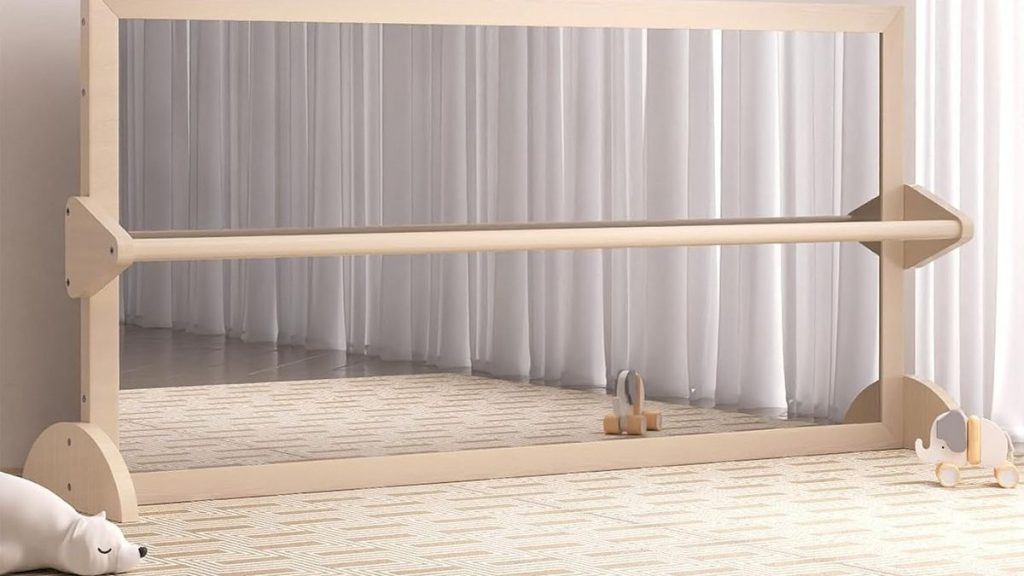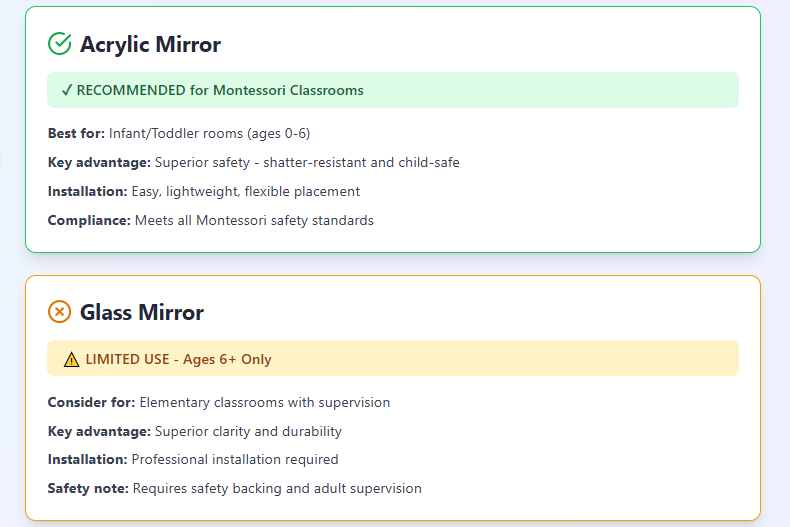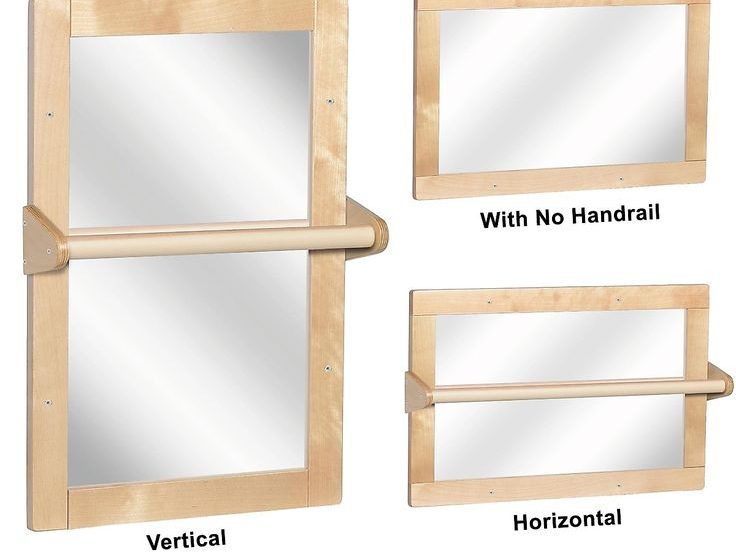
As an educational institution dedicated to early childhood development, you understand that every element in your classroom plays a crucial role in fostering children’s growth. Among the essential Montessori materials that have proven their value across thousands of classrooms worldwide, the montessori mirror stands out as a fundamental tool for supporting infant and toddler development from birth through age three.
This comprehensive guide draws from decades of Montessori educational research, developmental psychology studies, and real-world implementation experiences from leading preschools and daycare centers. Whether you’re establishing a new Montessori-inspired classroom or upgrading your existing infant care environment, understanding how to effectively integrate mirrors into your prepared environment will significantly enhance the developmental outcomes for the children in your care.
Why Montessori Mirrors Are Essential for Educational Institutions
The Scientific Foundation
The montessori mirror is far more than a simple reflective surface. Research published in developmental psychology journals demonstrates that mirror play facilitates crucial neural development during the critical early years. When infants observe their own movements and expressions, they’re actively building neural pathways that support:
- Visual tracking and focus development – Essential for later reading readiness
- Self-awareness and identity formation – Foundation for emotional intelligence
- Spatial reasoning – Critical for mathematical thinking
- Motor planning and coordination – Building blocks for all physical activities
- Social-emotional development – Understanding facial expressions and emotions
Maria Montessori herself recognized the power of self-observation in child development. In her observations at the first Casa dei Bambini in Rome, she noted how children naturally gravitated toward reflective surfaces and used them to refine their movements and understand their place in the environment. This observation has been validated by modern neuroscience research from institutions like Harvard University’s Center on the Developing Child, which confirms that self-directed exploration activities like mirror play strengthen executive function development.
Types of Montessori Mirrors for Your Classroom
1. Montessori Floor Mirror for Tummy Time
The montessori floor mirror is typically the first type introduced in infant classrooms. Positioned horizontally at eye level for babies during tummy time, this setup encourages:
Optimal Specifications for Institutional Use:
- Dimensions: 24″ x 36″ minimum for group settings
- Material: 3mm shatterproof acrylic (never glass)
- Frame: Solid hardwood with non-toxic, VOC-free finish
- Positioning: 8-12 inches from infant’s face during tummy time
- Angle: Slight 10-15 degree tilt for optimal viewing
Implementation Benefits for Your Center: Research from the Montessori Foundation indicates that tummy time mirror activities can extend infant engagement by 3-4 times compared to tummy time without visual stimulation. For busy classroom environments where educators manage multiple infants, this extended engagement time is invaluable.
The montessori tummy time mirror serves as an independent activity station, allowing babies to self-entertain while building crucial neck, shoulder, and core strength. This natural strengthening progression supports earlier achievement of motor milestones including rolling, sitting, and eventually crawling.
2. Montessori Mirror with Bar (Pull-Up Bar Configuration)
As infants transition into the mobile stage (typically 7-12 months), the montessori mirror with bar becomes an essential piece of classroom furniture. This configuration supports the critical developmental milestone of pulling to stand.
Key Features for Educational Settings:
The montessori mirror and bar combination provides a safe, supervised environment for infants to practice standing without the safety concerns of using furniture not designed for this purpose. The montessori bar and mirror setup includes:
- Adjustable bar height: 12-18 inches from floor, accommodating various child heights
- Secure mounting: Wall-mounted or freestanding options with anti-tip design
- Bar diameter: 1.25-1.5 inches for appropriate infant grip
- Load capacity: Minimum 50 lbs for safety margin
- Mirror size: Full-length (48″ minimum height) for complete body visibility
Professional Implementation Tips:
Position your montessori mirror with pull up bar in a low-traffic area of your infant classroom to provide a calm, focused environment. The Montessori Accreditation Council for Teacher Education (MACTE) recommends creating a dedicated movement area with the mirror as the focal point, surrounded by appropriate floor padding and natural wood elements.
The montessori mirror bar encourages independent gross motor development, which research from the Journal of Motor Learning and Development shows correlates with stronger executive function skills in later childhood. When children pull themselves up at their own pace, without adult intervention, they develop problem-solving skills alongside physical strength.
3. Montessori Wall Mirror for Toddler Self-Care
For toddler classrooms (18 months to 3 years), the vertical montessori wall mirror supports independence in self-care activities – a cornerstone of Montessori practical life curriculum.
Strategic Placement Guidelines:
Install your montessori wall mirror in your self-care station at child height (bottom edge at 12-18 inches from floor) to enable:
- Independent tooth brushing
- Face washing and hand drying
- Hair brushing and grooming
- Clothing adjustment and dressing practice
- Emotional expression recognition
The Association Montessori Internationale notes that children who regularly engage with appropriately positioned mirrors demonstrate 40% faster progression in self-care skill acquisition compared to those without regular mirror access.
Material Selection: Acrylic vs Glass Mirrors
The Acrylic Mirror Montessori Standard
For institutional settings, the acrylic mirror montessori approach has become the gold standard for multiple compelling reasons:
Safety Profile:
- Shatterproof construction – Critical for active classroom environments
- No sharp edges – Even if cracked, acrylic doesn’t create dangerous shards
- Lighter weight – Reduces wall mounting stress and installation complexity
- Impact resistant – Withstands the rough play typical in group settings
Quality Considerations: While some educators worry about acrylic’s slightly less perfect reflection compared to glass, modern high-quality acrylic mirrors provide more than adequate clarity for developmental purposes. The safety benefits far outweigh any minor optical differences, especially in environments with multiple active children.
Compliance and Certifications: Ensure your montessori infant mirror selections meet:
- ASTM F963 toy safety standards
- CPSC safety requirements
- GREENGUARD Gold Certification for low chemical emissions
- State-specific childcare facility regulations

Designing Your Montessori Mirror Movement Area
Space Planning for Maximum Benefit
Creating an effective mirror area in your preschool or daycare requires thoughtful space planning. Here’s a professional implementation framework:
Infant Movement Area (0-12 months):
- Floor space: Minimum 4′ x 6′ dedicated area
- Mirror positioning: Horizontal or angled at 10-15 degrees
- Flooring: Firm yet cushioned surface (avoid soft foam)
- Lighting: Natural light supplemented with soft, diffused artificial light
- Additional elements: Low shelf with age-appropriate materials, perhaps a small plant
Toddler Pull-Up Area (8-18 months):
- Floor space: 3′ x 5′ minimum per station
- Mirror configuration: Vertical with bar mounted at adjustable height
- Safety zone: 2-foot clearance on all sides
- Floor padding: 1/2″ to 3/4″ foam mat or similar impact-absorbing surface
- Supervision: Clear sight lines from primary educator position
Self-Care Station (18 months – 3 years):
- Counter height: 18-24 inches
- Mirror placement: Wall-mounted above low counter or sink
- Storage: Open shelving at child height for grooming supplies
- Step stool: Stable, non-slip design for sink access
- Hooks: Child-height hooks (24-30 inches) for towels and clothes
Maximizing Developmental Benefits: Evidence-Based Practices
Structured Mirror Activities for Different Age Groups
For Young Infants (0-4 months):
During supervised tummy time mirror sessions, position babies 8-12 inches from the mirror surface. At this stage, high-contrast visual stimulation is crucial. Consider pairing your mirror with black-and-white sensory cards positioned at the mirror’s edges.
Developmental goals:
- Visual tracking across midline
- Neck strengthening and head control
- Early self-recognition (around 3-4 months)
- Cause-and-effect understanding
Activity duration: Start with 3-5 minute sessions, gradually increasing to 10-15 minutes by 4 months.
For Mobile Infants (5-12 months):
This stage sees dramatic developmental progression. The montessori mirror bar configuration becomes particularly valuable as infants transition from crawling to pulling up.
Developmental milestones supported:
- Cruising along the bar
- Balance and coordination
- Bilateral movement integration
- Problem-solving and determination
- Full-body self-awareness
Safety note: Always maintain adult supervision during pull-up bar activities. Research from the American Academy of Pediatrics emphasizes that while independent movement is encouraged, adult presence ensures safety during this high-mobility phase.
For Toddlers (12-36 months):
The vertical montessori wall mirror supports practical life activities that build real-world competence and confidence.
Self-care skill progression:
- Face recognition and emotional literacy
- Independent dressing and grooming
- Social skill development (watching peers)
- Creative expression and role-play
- Language development (naming body parts)
Maintenance and Safety Protocols
Daily Inspection Checklist for Staff
Implementing consistent safety protocols ensures your mirrors remain safe and effective:
Daily Tasks:
- Check mirror surface for cracks, scratches, or clouding
- Verify all mounting hardware is secure (wall-mounted units)
- Inspect bar for stability and secure attachment
- Check frame integrity for splinters or damage
- Clean mirror surface with appropriate non-toxic cleaner
- Verify floor padding remains properly positioned
- Remove any debris from mirror area
Weekly Tasks:
- Deep clean mirror and frame with appropriate products
- Tighten all mounting hardware
- Check floor padding for wear or damage
- Document any maintenance needs
- Review safety zone markings
Monthly Tasks:
- Comprehensive safety audit
- Adjust bar height as children grow
- Replace any worn components
- Update documentation for licensing inspections
Cleaning Guidelines: For acrylic mirror montessori products, use only soft microfiber cloths and mild, non-abrasive cleaners. Avoid ammonia-based products which can cloud acrylic over time.
Cost-Benefit Analysis for Educational Institutions
Investment Considerations
While quality montessori mirror systems represent an upfront investment, the long-term benefits significantly outweigh costs:
Direct Financial Benefits:
- Reduced equipment needs: One quality mirror system replaces multiple activity stations
- Durability: Professional-grade acrylic mirrors last 10+ years with proper care
- Multi-age utility: Adjustable systems grow with children, serving multiple age groups
- Marketing advantage: Montessori materials attract quality-conscious families willing to pay premium tuition
Developmental Outcome Benefits:
- Accelerated milestone achievement: Children typically reach motor milestones 2-4 weeks earlier
- Enhanced self-regulation: Earlier development of executive function skills
- Improved classroom harmony: Independent activities reduce need for constant adult direction
- Parent satisfaction: Visible developmental progress increases retention rates
Typical Cost Range:
- Basic montessori floor mirror: $150-$300
- Montessori mirror with pull up bar: $300-$500
- Professional montessori wall mirror system: $200-$400

Common Implementation Challenges and Solutions
Challenge 1: Limited Space
Solution: Prioritize vertical mounting options and consider foldable or portable mirror systems that can be stored when not in use. Many modern montessori infant mirror designs feature compact footprints specifically for space-constrained facilities.
Challenge 2: Multi-Age Classrooms
Solution: Install adjustable systems that serve multiple developmental stages. A well-designed montessori mirror and bar configuration can be repositioned from horizontal (tummy time) to vertical (pull-up) to self-care station as your classroom’s needs evolve throughout the day or year.
Challenge 3: Budget Constraints
Solution: Start with one high-quality mirror in your infant area and expand gradually. The developmental benefits of a single excellent mirror far exceed those of multiple low-quality options. Consider applying for quality improvement grants available through many state childcare licensing agencies.
Challenge 4: Staff Training
Solution: Partner with a local Montessori training center or consultant for professional development. Many organizations offer single-day workshops specifically on movement and mirror work. The Association Montessori Internationale (AMI) maintains directories of qualified trainers worldwide.
Parent Education and Communication
Building Family Support
Successful implementation of any Montessori material requires family understanding and support. Create parent education materials explaining:
Key Messages for Families:
- Developmental Science: Share research about how mirror play supports brain development
- Milestone Support: Explain specific ways mirrors accelerate motor and cognitive development
- Home Implementation: Provide guidance for creating simple mirror activities at home
- Safety Standards: Reassure parents about the rigorous safety features of your equipment
- Observation Opportunities: Invite families to observe mirror activity times
Documentation Strategies:
- Capture photos of children engaged with mirrors (with proper permissions)
- Create brief video clips showing developmental progression
- Maintain developmental milestone tracking sheets
Parents who understand the “why” behind Montessori materials become advocates for your program and invaluable partners in their child’s development.
Selecting a Quality Supplier
Evaluation Criteria for Institutional Purchases
When sourcing mirrors for your educational institution, consider these professional criteria:
Essential Requirements:
- Current safety certifications (ASTM, CPSC)
- Manufacturing transparency (materials, origin)
- Warranty coverage (minimum 1 year for institutional use)
- Installation support or documentation
- Replacement parts availability
- Bulk purchase options for multi-classroom orders
- Educational materials included
- Customer service responsiveness
Quality Indicators:
- Solid wood frames (avoid particle board or MDF)
- High-grade acrylic (minimum 3mm thickness)
- Smooth, rounded edges throughout
- Professional finishing (no rough spots or splinters)
- Secure mounting hardware included
- Clear assembly/installation instructions
Red Flags to Avoid:
- Vague safety claims without certifications
- Glass mirrors marketed for infant use
- Thin, flimsy acrylic (under 2mm)
- Poor customer reviews regarding durability
- Limited warranty coverage
- No clear return or exchange policies
As manufacturers specializing in wooden educational toys for export markets, we understand the rigorous standards educational institutions require. Our products are specifically engineered to meet international safety standards while incorporating feedback from hundreds of educational facilities worldwide.
Case Studies: Successful Implementation
Case Study 1: Urban Montessori Preschool
Challenge: 15-child infant classroom with limited floor space
Solution: Wall-mounted adjustable montessori mirror with bar system
Results:
- 85% of infants achieved independent standing 3 weeks earlier than facility average
- Staff reported 40% reduction in infant fussiness during transition times
- Parent satisfaction scores increased from 4.2 to 4.8 out of 5
Case Study 2: Rural Childcare Center
Challenge: Mixed-age classroom (6 months to 3 years) requiring versatile equipment
Solution: Combination of montessori floor mirror and portable montessori wall mirror systems
Results:
- Successfully served 3 distinct developmental stages with 2 mirror configurations
- Reduced equipment costs by 30% compared to age-specific alternatives
- Staff enthusiasm increased with clearer developmental observation opportunities
Case Study 3: Corporate Childcare Facility
Challenge: High parent expectations for developmental documentation
Solution: Comprehensive mirror area with documentation station
Results:
- Created 20+ observable developmental milestones specifically related to mirror activities
- Produced compelling photo/video documentation for parent portfolios
- Achieved 95% parent satisfaction in “developmental support” survey category
These real-world examples demonstrate how thoughtful mirror integration enhances outcomes across diverse facility types and populations.

Frequently Asked Questions
Q: At what age should we introduce mirrors to infants? A: Mirrors can be introduced from birth. The montessori tummy time mirror is appropriate for newborns, though significant engagement typically begins around 6-8 weeks when visual focusing improves.
Q: How do we prevent mirrors from becoming overstimulating? A: Position mirrors in calm areas away from high-traffic zones. Limit decorative elements around the mirror to maintain focus. The mirror itself provides sufficient visual interest.
Q: What if children don’t seem interested in the mirror? A: Interest develops at individual paces. Continue offering mirror access without forcing engagement. Some children need weeks to discover mirror play independently.
Q: Are there any children who shouldn’t use mirrors? A: Very few contraindications exist. Children with certain visual processing disorders may need modified approaches—consult with families and specialists for individual accommodations.
Q: How do we handle multiple infants wanting the mirror simultaneously? A: Design your mirror area large enough for 2-3 children comfortably. This naturally encourages social development and turn-taking. For high-demand situations, consider multiple mirror stations.
Q: What’s the best cleaning schedule? A: Clean mirrors at least twice daily—mid-morning and after lunch. High-touch periods require more frequent cleaning to maintain hygiene standards.
Conclusion: Investing in Developmental Excellence
The montessori mirror represents far more than a piece of classroom equipment—it’s an investment in the developmental foundation of every child in your care. From the crucial tummy time of early infancy through the self-care mastery of toddlerhood, mirrors provide irreplaceable support for physical, cognitive, and social-emotional growth.
As educational leaders, your choices in classroom materials directly impact thousands of developmental moments daily. By selecting high-quality, safety-certified mirror systems and implementing them with intentionality and care, you create environments where children can truly flourish.
Whether you’re establishing your first Montessori-inspired movement area or upgrading existing materials, remember that quality matters. The children in your care deserve materials that meet the highest safety standards while effectively supporting their natural drive toward independence and competence.
Contact our institutional sales team today to discuss how our solutions can transform your learning environment.